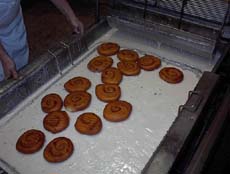|
"Penny"
Griffith came on board four months later and has been working there ever since.
"It
started out as a summer job and I just stayed," she said. "I work out
front and then help with book work and anything else that needs to be
done," Griffith added.

Betty
Dodson, who has been on board for about five years, and Griffith take care of
the front end of the business during the week, and several part-time employees
work the weekends.
The
actual process for each day's goods begins with Meyer and three other full-time
employees making the dough, from scratch, and then letting it "proof."
The next step is cutting the large batch into smaller batches for each specific
item that is on the schedule to be made that day.
Large
metal rolling pins with templates of bear claws, triangles, bismarcks, long
johns and doughnuts roll across the dough, cutting it into each specific shape.
Meyer
and his employees make everything.
"All
of our dough, glazes and icings are made here," Meyer said. "Some
places use frozen dough and buy their icings in a tub. We don't do it that
way," he said.
None
of the finished items is trucked in from a central location. Griffith said that
at times some of their customers initially thought that they just distributed
the items that were made someplace else.

It's
apparent that every step in the process hinges on a number of factors.
"Bea" Sisk, who has been at Mel-O-Cream for 18 years, said that not
only does it take timing, but also the outside temperature and humidity play a
big factor.
"When
it starts to get hot and humid, the dough will rise faster," she said.
"When that happens, you have to work a little faster so it doesn't get away
from you," Sisk added.
She
also pointed out that it was necessary for the four of them that do the actual
cooking to know each other's job.
"Whatever
needs to be done at each step for that particular type of doughnut or pastry, we
all need to be able to do that job," she said.
Scott
Laubenstein, low man on the totem pole with two years-plus under his belt, mans
the cooker.
"When
cooking the 'Mel-O-Cream Donut,' I watch the center of the doughnut. When it
starts to turn brown, I start turning them over," Laubenstein said.
"The
color I look for is the light brown of fried chicken. When it reaches that
point, the doughnuts are done," he added.
(To
top of second column)
|

Laubenstein
generally has about 12 dozen donuts or rolls in process at one time.
"While
three dozen are cooking, three dozen on the previous tray are
draining and three dozen are being glazed," he said.

"Not
only is the temperature of the room a factor in the final
product," Laubenstein said, "but the temperature of the
doughnuts and rolls when being glazed and iced is important. If it's
too hot, the glaze and icing will run off, and if they're too cool
it won't stick right," he said.
Laubenstein
agreed with Sisk and said that in the past if it got too hot inside
they would add ice to the water and flour when making the dough so
that it would take longer for it to rise.
Sisk
also added that during the summer months, they don't make cream
puffs or the French doughnuts.
"Because
of the amount of eggs in the cream puffs and French doughnuts, they
could turn bad in the heat. You can't let them set out like you can
the other types of pastries," Sisk commented.
"Along
with the traditional doughnuts and rolls during the week, we also
make several other types for weekends when the demand is
greater," she added.

"Carl
also lets us experiment if we have an idea," she said.
"Last week we made a raisin/pecan twist. If it goes over, we
add it to the menu. So far, it has."
There
are customers that are a part of the daily routine and there are
those that have to stop in when visiting. Some of the visitors make
it yearly and some less frequently.
Whether
stopping in to see Meyer and his employees or actually being one of
the employees, it's apparent to see why good traditions shouldn't be
broken.
[Fuzz
Werth]
|

